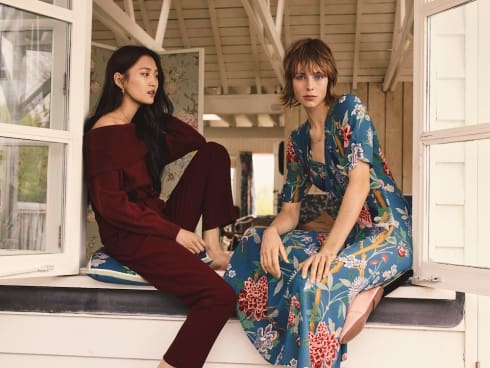Humans have been collaborating on artistic projects since Ugg the Neanderthal added more burnt sienna to his pal’s cave drawing of a mammoth. Why, the tendency to team up isn’t even new in fashion: designer Elsa Schiaparelli and artist Salvador Dali famously worked together in the 1930s. But, in the past two or three years, clothing brands have been hooking up more than a newly single guy on Tinder. For his Vetements spring-summer 2017 collection, fashion darling Demna Gvasalia threw his whole collection to 18 different collaborators, from Levi’s to Dr Martens to Juicy Couture.
“Fashion has always been a creative process and creativity thrives on collaboration,” says stylist and fashion expert Steven Schelling. “Just as an established luxury house can benefit from a bit of new blood and new vision, the up-and-comer can steal a little of the luxury brand’s global lustre for themselves.”
It can also, says Vancouver stylist Michelle Addison, be about luxury brands reaching new audiences: “It’s exciting to tap into lower-price-point markets and give consumers a taste of the designer world that they would not necessarily be able to afford otherwise.”
One high-street brand bringing all the big hitters into its fold is H&M, which started with a bang by linking with Karl Lagerfeld in 2004 and has since worked with everyone from Comme des Garçons to Balmain. It mostly sticks to partners within the fashion and design realm—its latest collection, which launched in August, is with British wallpaper and textile house GP & J Baker, which is famous for its pretty prints.
Japanese behemoth Uniqlo is also a major player when it comes to so-called collabs, making clever alliances with everyone from fashion grandees like Jil Sander to pop-culture icons like Sesame Street, which typically appear on the brand’s UT limited-edition graphic tees. According to UNIQLO Canada’s Kat Adams, collaborations can provide useful feedback.
“UNIQLO can learn from partners to refine its understanding of apparel and contemporary tastes, translating this into great designs, silhouettes and attention to detail,” she says, adding that a key to collaboration success is not to mess too much with the core product.
“We always stay true to Vans heritage and roots, even when collaborating with a partner,” agrees Stephen Mills, vice-president of lifestyle product merchandising for the skateboarding shoes and apparel brand, which is launching a cheeky Vans x Van Gogh collection for this fall—Balenciaga and Crocs (yes, it happened) take note.
Brands often also use their collabs to reposition themselves. Coach has said goodbye to its reputation as a fusty old fashion house, mostly through the genius of creative director Stuart Vevers but also by working with brands like the ultra-hip Rodarte and most recently, millennial movie and music star Selena Gomez, who has co-created a full ready-to-wear collection after doing handbags and accessories last fall. Michael Kors, too, has a history of collaborations that capitalize on pop culture; this season, the designer’s worked with Vogue fashion illustrator David Downton on a capsule collection that rubberstamps the brand’s elevation from mass to luxe.
So what next for fashion collabs, or are we seeing the end? “We are likely just getting started,” says Addison. “If the younger generation is buying more fashion than the older generation ever did, then it makes sense that celebrity endorsements, Instagram and approachable price points are dictating the direction of the industry.”
Schelling, with his cynical fashion head on, adds, “The celebrity collab is just getting revved up. In a twist to Andy Warhol’s 15 minutes of fame, every reality star with a pencil and a dream will be signed on to ‘design’ something and then we’ll have to dutifully write about it and fans will lap it up." (Guilty as charged.)
But for some brands, the collaboration does come from a noble place. There are, for instance, the hookups that seek to expose an issue, or raise money for charity. Take Toronto bespoke leather jacket maker Namesake, which recently joined forces with visual artists from all over Canada and Europe to create one-of-a-kind coats that will premiere at that city’s fashion week and, after, be sold, with profits going to Fashion Revolution, which aims to make the fashion industry more ethical.
And then there are those labels for which collaboration is part of a philosophy, not just a commercial endeavour. This seems to chime with where we’re at right now culturally—social networking means working together is the norm, not the exception, ensemble movies dominate the big screen and movements like #timesup focus on joining forces and amplifying others’ voices, not individualism and competition.
Vancouver’s Brunette the Label has a "babes supporting babes" mantra, using its website and social media to shine a light on inspiring women—entrepreneurs, activists, athletes and more, and working on collaborative projects with everyone from The Coveteur to Goop. Its latest partner is Melissa Stackhouse, director of winemaking for Meiomi Wines, with whom Brunette created a "Pinot Please" logo-ed sweatshirt. Founder Miriam Alden particularly wanted to work with Stackhouse because she’s one of just a few women making waves (and wine) in a male-dominated industry.
"To us, ‘babes supporting babes’ is about collaboration over competition, and always making room to grow together," Alden says. "It is choosing to take yourself out of the equation and always supporting one another.” —Aileen Lalor




Be the first to comment